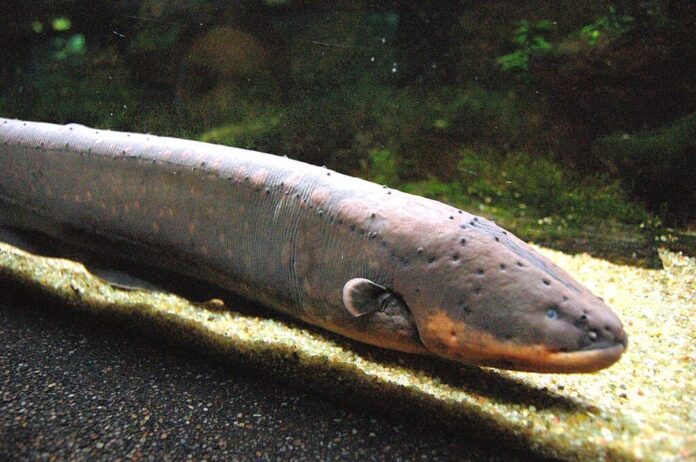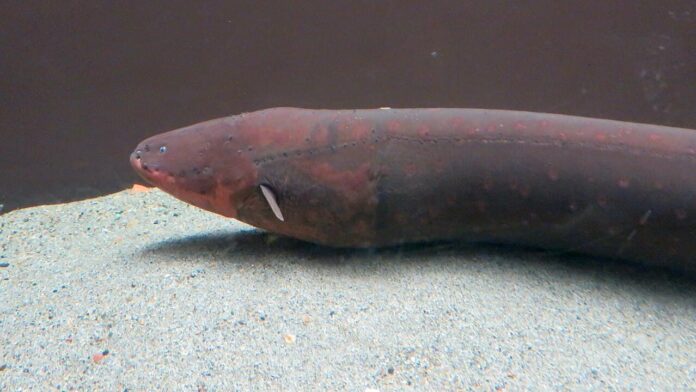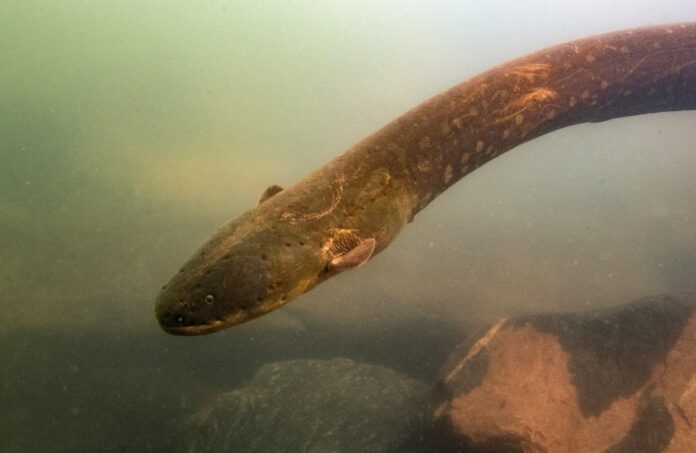Do you know that there are 3 electric eel species out there? We all know about their ability to produce electricity to stun their prey, but what about the family members of this species? Have you ever wondered if different species have different levels of shocking ability? This is what we are going to talk about today, so let’s dive deeper and find out.
1Electric Eel

Scientific Name: Electrophorus Electricus
This is the best-known electric eel species among the rest, but it is actually not an eel. It is a knifefish, just a freshwater fish that has electrogenic tissue that can produce electric discharges. An electric eel has an elongated and cylindrical body that measures up to 2 meters or even longer. It is dark gray-brown on the back and yellow or orange on the belly, and mature females have a darker abdomen. Just like other electric eels in the family, this one also has thick and scaleless skin that is slimy.
Being a freshwater fish, this electric eel species lives in freshwater habitats across northern South America. Its range is distributed in the Amazon Basin, Brazilian Basin, and the Guiana Shield, where they inhabit flooded forests, lakes, pools, and streams. Electric eels mainly dwell on the muddy bottoms of rivers, swamps, and preferably deeply shaded areas. In their habitats, they feed on amphibians, crustaceans, fish, insects, invertebrates, and even small mammals like rats. Since they lack teeth, electric eels open their mouths to create a suction that allows them to eat prey with ease.
When it comes to electricity generation, an electric fish can generate up to 600 volts of electricity. At the same time, there are different levels and ways that they use their special power for. The low voltages are electrolocation, to communicate, detect prey, and navigate. This is because they are mostly blind, so they rely on low-level electrical pulses to explore their surrounding. As for the high voltages, they are used to detect prey, stun, and kill them. Electric eels don’t attack humans unless provoked, and human deaths from them are also very rare. However, multiple shocks can cause heart or respiratory failure, leading to drowning even in shallow water.
2Vari’s Electric Eel

Scientific Name: Electrophorus Varii
Being the oldest electric eel species, but was just discovered in 2019, the data on Vari’s electric eels is still inadequate. Appearance-wise, it has a long slender body with a flat head. Its scaleless body is dark gray to brown, with a yellow-orange underside. Unlike the electric eels, Vari’s electric eels do not have a clear body band. It is quite short, compared to other electric eels, being only around 1.4 meters maximum. If we talk about electricity, Vari’s electric eels produce maximum voltage at around 570 volts.
This one is also from South America, inhabiting the lowland habitats of the Amazon Basin and some streams in the Guiana Shield. The unique thing about this electric eel species is that it is adapted to only upland shield habitats. So they live in turbid rivers with little oxygen, and muddy or sandy bottoms where they swim through murky and slow-flowing lowland waters. Across their range. These eels feed on amphibians, aquatic insects, crustaceans, and fish.
3Volta’s Electric Eel

Scientific Name: Electrophorus Voltai
Looking very similar to electric eels, it can be challenging to distinguish between the two. You can tell a Volta’s electric eel by its head which is flatter and wider. It reaches a similar length to the electric eels, 2.5 meters, and males are longer than females. The coloration and shape are pretty similar, with gray-brown skin and a yellowish-orange belly.
Volta’s electric eels are residents of the Amazon River or its tributaries. They inhabit upland habitats, primarily north-flowing rivers of the Brazilian Shield and the south-flowing rivers of the Guiana Shield as well. This electric eel species likes to forage alone at night, when active prey fish are resting in a lethargic state in shallow waters. However, there was this one occasion when researchers found over 100 of these eels hunting as a group. It occurred in a small lake connected with the Iriri River, and it is the only location where this behavior has been observed.
Here you are looking at the electric eel species that produces the strongest electric discharge. It can generate up to 860 volts of electricity, the strongest bioelectricity generation in any animal. This incredible ability is for nothing but hunting and protecting themselves from predators. And not different from other members in the family, they also use low electrical pulses to navigate. Since they live in muddy waters, this helps a lot.
Related Post: Electric Rays You Don’t Know Exist




